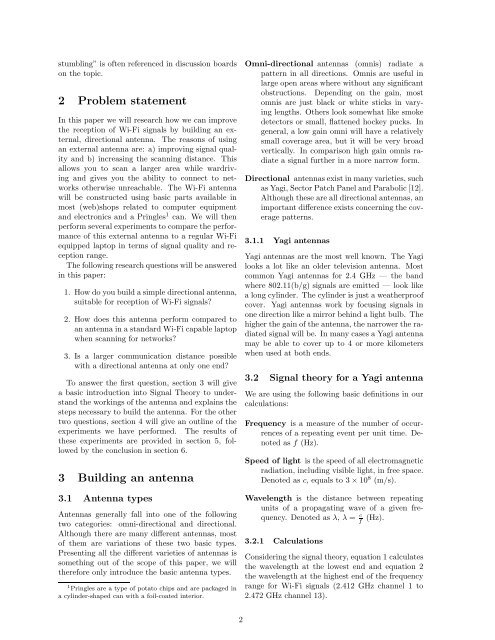Wardriving - Building A Yagi Pringles Antenna - LoonyDesk!
Wardriving - Building A Yagi Pringles Antenna - LoonyDesk!
Wardriving - Building A Yagi Pringles Antenna - LoonyDesk!
Create successful ePaper yourself
Turn your PDF publications into a flip-book with our unique Google optimized e-Paper software.
stumbling” is often referenced in discussion boards<br />
on the topic.<br />
2 Problem statement<br />
In this paper we will research how we can improve<br />
the reception of Wi-Fi signals by building an external,<br />
directional antenna. The reasons of using<br />
an external antenna are: a) improving signal quality<br />
and b) increasing the scanning distance. This<br />
allows you to scan a larger area while wardriving<br />
and gives you the ability to connect to networks<br />
otherwise unreachable. The Wi-Fi antenna<br />
will be constructed using basic parts available in<br />
most (web)shops related to computer equipment<br />
and electronics and a <strong>Pringles</strong> 1 can. We will then<br />
perform several experiments to compare the performance<br />
of this external antenna to a regular Wi-Fi<br />
equipped laptop in terms of signal quality and reception<br />
range.<br />
The following research questions will be answered<br />
in this paper:<br />
1. How do you build a simple directional antenna,<br />
suitable for reception of Wi-Fi signals?<br />
2. How does this antenna perform compared to<br />
an antenna in a standard Wi-Fi capable laptop<br />
when scanning for networks?<br />
3. Is a larger communication distance possible<br />
with a directional antenna at only one end?<br />
To answer the first question, section 3 will give<br />
a basic introduction into Signal Theory to understand<br />
the workings of the antenna and explains the<br />
steps necessary to build the antenna. For the other<br />
two questions, section 4 will give an outline of the<br />
experiments we have performed. The results of<br />
these experiments are provided in section 5, followed<br />
by the conclusion in section 6.<br />
3 <strong>Building</strong> an antenna<br />
3.1 <strong>Antenna</strong> types<br />
<strong>Antenna</strong>s generally fall into one of the following<br />
two categories: omni-directional and directional.<br />
Although there are many different antennas, most<br />
of them are variations of these two basic types.<br />
Presenting all the different varieties of antennas is<br />
something out of the scope of this paper, we will<br />
therefore only introduce the basic antenna types.<br />
1 <strong>Pringles</strong> are a type of potato chips and are packaged in<br />
a cylinder-shaped can with a foil-coated interior.<br />
2<br />
Omni-directional antennas (omnis) radiate a<br />
pattern in all directions. Omnis are useful in<br />
large open areas where without any significant<br />
obstructions. Depending on the gain, most<br />
omnis are just black or white sticks in varying<br />
lengths. Others look somewhat like smoke<br />
detectors or small, flattened hockey pucks. In<br />
general, a low gain omni will have a relatively<br />
small coverage area, but it will be very broad<br />
vertically. In comparison high gain omnis radiate<br />
a signal further in a more narrow form.<br />
Directional antennas exist in many varieties, such<br />
as <strong>Yagi</strong>, Sector Patch Panel and Parabolic [12].<br />
Although these are all directional antennas, an<br />
important difference exists concerning the coverage<br />
patterns.<br />
3.1.1 <strong>Yagi</strong> antennas<br />
<strong>Yagi</strong> antennas are the most well known. The <strong>Yagi</strong><br />
looks a lot like an older television antenna. Most<br />
common <strong>Yagi</strong> antennas for 2.4 GHz — the band<br />
where 802.11(b/g) signals are emitted — look like<br />
a long cylinder. The cylinder is just a weatherproof<br />
cover. <strong>Yagi</strong> antennas work by focusing signals in<br />
one direction like a mirror behind a light bulb. The<br />
higher the gain of the antenna, the narrower the radiated<br />
signal will be. In many cases a <strong>Yagi</strong> antenna<br />
may be able to cover up to 4 or more kilometers<br />
when used at both ends.<br />
3.2 Signal theory for a <strong>Yagi</strong> antenna<br />
We are using the following basic definitions in our<br />
calculations:<br />
Frequency is a measure of the number of occurrences<br />
of a repeating event per unit time. Denoted<br />
as f (Hz).<br />
Speed of light is the speed of all electromagnetic<br />
radiation, including visible light, in free space.<br />
Denoted as c, equals to 3 × 10 8 (m/s).<br />
Wavelength is the distance between repeating<br />
units of a propagating wave of a given frequency.<br />
Denoted as λ, λ = c<br />
f (Hz).<br />
3.2.1 Calculations<br />
Considering the signal theory, equation 1 calculates<br />
the wavelength at the lowest end and equation 2<br />
the wavelength at the highest end of the frequency<br />
range for Wi-Fi signals (2.412 GHz channel 1 to<br />
2.472 GHz channel 13).


